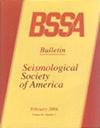Uncertainties in Broadband Determination of the High-Frequency Spectral Decay, Kappa, in Eastern Canada
IF 2.9
3区 地球科学
Q2 GEOCHEMISTRY & GEOPHYSICS
引用次数: 0
Abstract
Kappa (the high-frequency spectral decay slope at near-source distances; often referred to as κ0) is determined at 25 seismograph stations in Eastern Canada using broadband ground-motion modeling approaches. The database comprises Fourier spectra (effective amplitude spectrum for the horizontal component and the vertical component, 0.8–40 Hz) computed from 3318 earthquakes of moment magnitude M 1.5–5 recorded on stations within 150 km. Average kappa values for bedrock sites, having shear-wave velocities from 850 to 2400 m/s, are highly variable, ranging from −29 to +21 ms (horizontal) and −28 to +11 ms (vertical), but appear on average to be near-zero. The values obtained are sensitive to methodology, especially the necessary adjustments to the spectra to account for site amplification effects. Kappa values do not appear to correlate well with site parameters such as rock shear-wave velocity, average shear-wave velocity in the upper 30 m, primary wave velocity, site class, type and age of rock, or instrument housing. This lack of correlation may reflect the noted sensitivities to methodological factors. We conclude that kappa values in rock environments are not reliably estimated from such proxies and should be determined from recorded ground motions at a given location. On average, there is little evidence of significant high-frequency attenuation on rock sites beyond that already accounted for in ground-motion modeling by the empirical parameterization of regional Q-related path effects.高频频谱衰减的宽带测定中的不确定性,Kappa,加拿大东部
Kappa(近源距离高频频谱衰减斜率;通常被称为κ0)是在加拿大东部的25个地震台使用宽带地面运动模拟方法确定的。该数据库包括从150公里范围内台站记录的3318次矩震级为M 1.5-5的地震中计算出的傅里叶谱(水平分量和垂直分量的有效振幅谱,0.8-40 Hz)。横波速度为850 ~ 2400 m/s的基岩站点的平均kappa值变化很大,范围为- 29 ~ +21 ms(水平)和- 28 ~ +11 ms(垂直),但平均来看接近于零。所得的值对方法很敏感,特别是对光谱进行必要的调整以考虑位点放大效应。Kappa值似乎与场地参数不太相关,如岩石剪切波速度,30米以上的平均剪切波速度,主波速度,场地类别,岩石类型和年龄,或仪器外壳。这种相关性的缺乏可能反映了对方法学因素的敏感性。我们的结论是,岩石环境中的kappa值不能从这些代理中可靠地估计出来,而应该从给定位置记录的地面运动中确定。平均而言,除了通过区域q相关路径效应的经验参数化在地震动建模中已经考虑到的高频衰减之外,几乎没有证据表明岩石位置上存在显著的高频衰减。
本文章由计算机程序翻译,如有差异,请以英文原文为准。
求助全文
约1分钟内获得全文
求助全文
来源期刊

Bulletin of the Seismological Society of America
地学-地球化学与地球物理
CiteScore
5.80
自引率
13.30%
发文量
140
审稿时长
3 months
期刊介绍:
The Bulletin of the Seismological Society of America, commonly referred to as BSSA, (ISSN 0037-1106) is the premier journal of advanced research in earthquake seismology and related disciplines. It first appeared in 1911 and became a bimonthly in 1963. Each issue is composed of scientific papers on the various aspects of seismology, including investigation of specific earthquakes, theoretical and observational studies of seismic waves, inverse methods for determining the structure of the Earth or the dynamics of the earthquake source, seismometry, earthquake hazard and risk estimation, seismotectonics, and earthquake engineering. Special issues focus on important earthquakes or rapidly changing topics in seismology. BSSA is published by the Seismological Society of America.
 求助内容:
求助内容: 应助结果提醒方式:
应助结果提醒方式:


